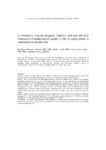Mostrar o rexistro simple do ítem
A therapeutic exercise program improves pain and physical dimension of health-related quality of life in young adults: a randomized controlled trial
| dc.contributor.advisor | ||
| dc.contributor.author | Rodríguez-Romero, Beatriz | |
| dc.contributor.author | Bello, Olalla | |
| dc.contributor.author | Vivas-Costa, Jamile | |
| dc.contributor.author | Carballo-Costa, Lidia | |
| dc.date.accessioned | 2019-09-23T11:57:54Z | |
| dc.date.issued | 2019-05 | |
| dc.identifier.citation | Rodríguez Romero B, Bello O, Vivas J, Carballo Costa L. A therapeutic exercise program improves pain and physical dimension of health-related quality of life in young adults: a randomized controlled trial. Am J Phys Med Rehabil. 2019; 98(5):398-392. | |
| dc.identifier.issn | 08949115 | |
| dc.identifier.uri | http://hdl.handle.net/2183/23968 | |
| dc.description | Original Research | es_ES |
| dc.description.abstract | [Abstract] Objective. The aim of this study was to evaluate the effects of an exercise therapy program on pain and physical dimension of health-related quality of life for young adults with musculoskeletal pain. Design. This is a randomized controlled single-blind trial. Fifty-seven subjects (58% women) were randomly assigned to experimental [n = 28, 21.4 (2.9) yrs] and control [n = 29, 21.0 (4.2) yrs] groups. The experimental group participated in a 9-wk stabilization exercise therapy program, 60 mins/wk, whereas the control group did not exercise, with a preintervention and postintervention assessment. Primary outcome was Physical Component Summary of SF-36. Secondary outcomes were Nordic Musculoskeletal Questionnaire, Visual Analogue Scale, Oswestry Disability Index, Neck Disability Index, and Trunk Flexor Endurance Test. The Shapiro-Wilk, independent t test or Mann-Whitney U test, X2, or Fisher's exact test were used for statistical analysis. Results. After intervention, the experimental group improved by 3.2 (4.5) points on the Physical Component Summary (P = 0.01), decreased prevalence of low back pain in the last month (P = 0.02) and cervical disability (P = 0.02), and increased flexor trunk endurance (P = 0.005). Conclusions. This study confirmed that a 9-wk progressive exercise therapy program can improve physical health and reduce the prevalence of cervical disability and low back pain in the last month in young adults with musculoskeletal pain. Musculoskeletal pain (MSP) is a significant health problem in society and has been shown to have a major impact on health-related quality of life, for both physical and mental health (MH),1–3 and this may be even more relevant in a young population. Most people who experience this type of pain go on to have recurrent episodes.3 The prevalence of MSP in younger people, such as university students, has increased significantly in the last decade because of different factors such as sedentary lifestyle with increased use of computers, low physical activity levels, poor sleeping habits, or psychosocial factors.4 The most common locations with symptoms include neck and shoulder regions, lumbar region, and simultaneously in multiple other regions.4 They may have a number of negative effects, including more generalized and chronic pain.1,2 Considering the increasingly higher prevalence of MSP in young adults and the predictive value that this pain has on suffering MSP as an adult, it seems appropriate to focus greater attention on early prevention at a young age. Exercise therapy has been investigated extensively, and there is evidence that it is effective for the prevention and treatment of low back and cervical pain.5,6 Although there is limited evidence regarding the specific content of exercises, their intensity, as well as the number, duration, and frequency of sessions; the accumulated evidence5–9 on the topic provides the best indications for which and how therapeutic exercises should be used. In the case of subjects with lower back pain (LBP), the most recommended exercises consist of coordination, relaxation, and resistance of the trunk muscles,7 as well as motor control or dynamic stabilization exercises and integrated activation of the global muscles.9 In turn, in subjects with neck pain, the recommended methods involve strengthening, resistance, stretching, and stabilization exercises.6,8 Despite the available evidence regarding the effects of exercise therapy on the prevention of MSP, we have found hardly any studies that apply this to young adults.10 However, we consider that more attention should be paid to this collective because of their imminent incorporation in the labor market, and the socio-economic consequences these symptoms may have for these future workers and their employers. Taking into consideration the increase in MSP in younger persons, the evidence supporting exercise therapy for its prevention in adults, and at the same time the lack of consensus regarding the specific characteristics of the intervention program, this study aims to evaluate the effect of a progressive, multimodal therapeutic exercise program on pain, physical health, disability, and trunk flexor muscle endurance in a group of young university adults. | es_ES |
| dc.language.iso | eng | es_ES |
| dc.publisher | Wolters Kluwer | es_ES |
| dc.relation.uri | https://doi.org/10.1097/PHM.0000000000001107 | es_ES |
| dc.rights | This is a non-final version of an article published in final form in American Journal of Physical Medicine & Rehabilitation | es_ES |
| dc.subject | Exercise therapy | es_ES |
| dc.subject | Musculoskeletal pain | es_ES |
| dc.subject | Quality of life | es_ES |
| dc.subject | Physical therapy modalities | es_ES |
| dc.title | A therapeutic exercise program improves pain and physical dimension of health-related quality of life in young adults: a randomized controlled trial | es_ES |
| dc.type | info:eu-repo/semantics/article | es_ES |
| dc.rights.access | info:eu-repo/semantics/embargoedAccess | es_ES |
| dc.date.embargoEndDate | 2020-05-01 | es_ES |
| dc.date.embargoLift | 2020-05-01 | |
| UDC.journalTitle | American Journal of Phyisical Medicine and Rehabilitation | es_ES |
| UDC.volume | 98 | es_ES |
| UDC.issue | 5 | es_ES |
| UDC.startPage | 392 | es_ES |
| UDC.endPage | 398 | es_ES |
Ficheiros no ítem
Este ítem aparece na(s) seguinte(s) colección(s)
-
GI-IPRF - Artigos [147]






